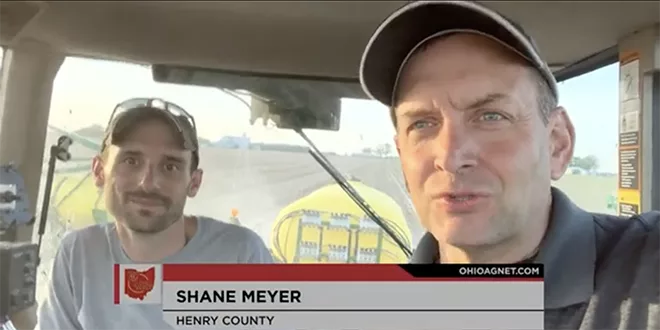The 2022 planting season has frustrated Ohio crop growers. A chilly spring along with saturated soils and steady rainfall delayed planting. However, by the end of May, farmers closed the wide planting progress gap.
On Ohio's Wood/Henry County line, farmer Shane Meyer planted soybeans in late May. He talked to the Ohio Country Journal about planting this year and his planter technology.
“We are running starter fertilizer with this field for soybeans. Last year, I ran on strip-till, and we had a 7-bushel bump when I was running 30-inch on strip-till. This year we’re trying no-till on 30-inch rows with starter to eliminate that pass. Then I’ll run around 5 acres without starter, and then we’re going to drill the rest of them and see if we get a yield bump,” says Meyer.
The John Deere planter has hydraulic downforce, electric meters and Precision Planting eSet meters. He also runs 360 Yield Center 360 BANDITs for banding nitrogen and 360 Yield Center WAVEs, angled blades that slice through the seed-trench sidewall and delivers starter to the side and below the seed. The planter also has hydraulic row cleaners that Meyer can adjust on the fly.
“We can go from zero PSI when they are lifted to 3,000+ at the turn of the nob, and it is almost instant," Meyer says. "This particular farm has a 10-acre blowsand hill on it, and the rest of it is a heavy Hoytville clay. I can flip that switch on the fly so I am not digging a trench with the row cleaners when I hit the sand hill and then readjust when we get back down to the heavy clay.”
Meyer prioritizes trying new farming methods and technologies. His current seeding rate is 140,000. He's using a planter split into 4-row sections so he can push a button to switch to 130,000 seeds where needed. In addition, Meyer is doing multiple tests, including pop-up, starter, no pop-up, drilled vs. 30-inch, and the drill on 7.5 inches with a 180,000 population.
All the data flows into Ag Leader's SMS program, which he can use to draw maps. He'll typically run 2 varieties of corn all the time with the planter.
"Normally, it is six and six but since I am testing the WAVE, I was doing 3 of variety A, 6 of variety B and then 3 of variety A with the wave," Meyer says. "This year I am doing 3 of variety A without the Wave, 6 of variety B with the wave and 3 of variety A with the Wave. The last 2 years I have seen the benefit of that and I wanted to try it in one more year of testing. With 3 years of showing a benefit, the planter gets it all the way across. And with the Ag Leader SMS, you can select certain passes or certain rows, take that data, pin it and then invert your selection to get the data not selected prior to compare the data. It makes data very seamless.”
Hear more from Meyer in the video below from Ohio Ag Net.






